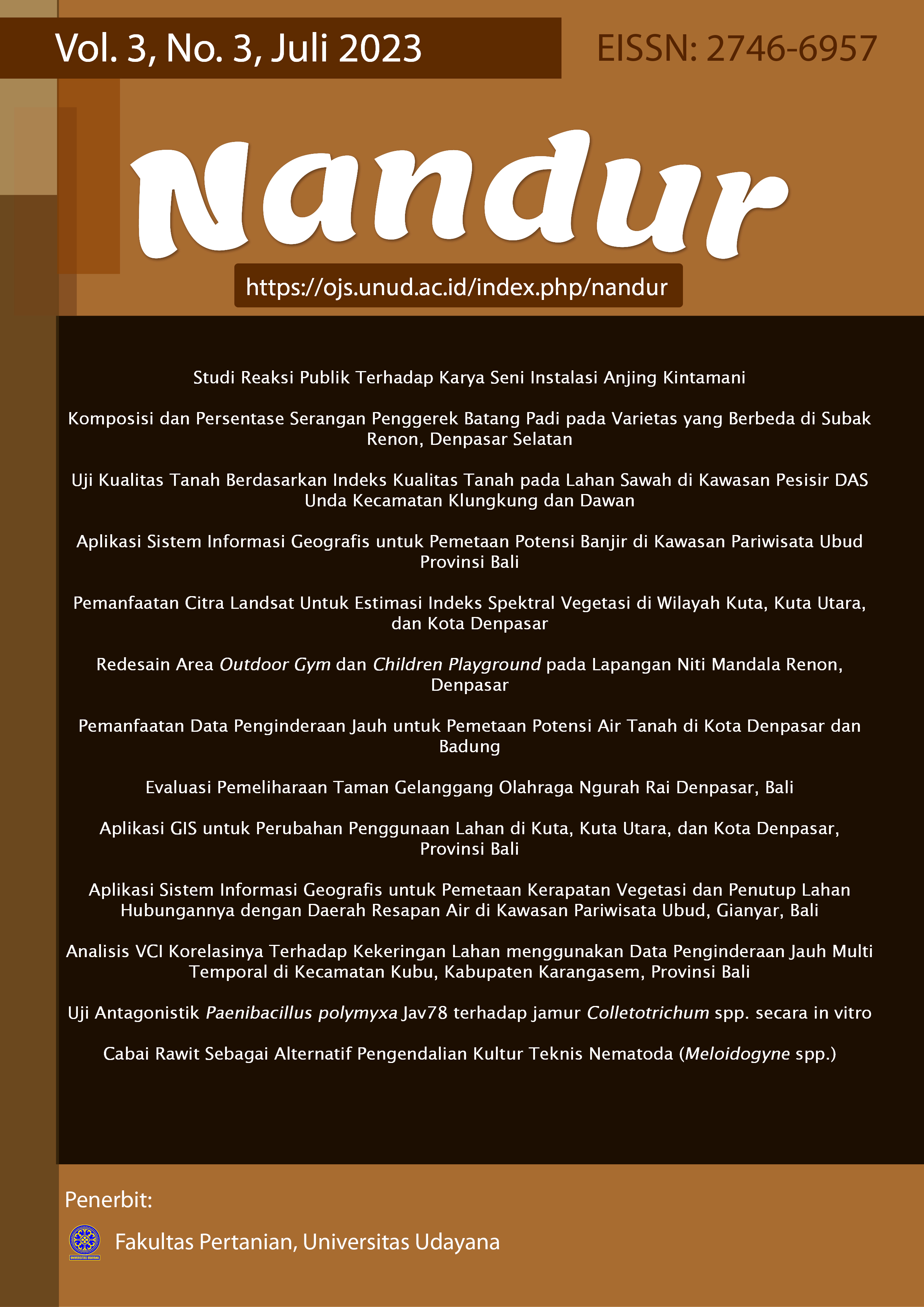Aplikasi Sistem Informasi Geografis untuk Pemetaan Potensi Banjir di Kawasan Pariwisata Ubud Provinsi Bali
Abstract
The Ubud Tourism Area is a tourism area which is located on a fairly high plateau but floods often occur, especially when rainfall is high. The parameters causing potential flooding in the Ubud Tourism Area are river distance, altitude, slope, rainfall, land use and soil type. The purpose of this study is to provide information on the distribution of potential flooding in the Ubud Tourism Area in the form of mapping related to the awareness of the public and tourists against flood disasters. This research was conducted in Ubud District from October 2022 to January 2023. The research method used is the scoring and weighting method as well as the overlay of the parameters that cause potential flooding. The OSM Tracker application is used for field checking by checking potential flood points spread out in the study area. The results of the study show that there are five classes of potential flooding, namely very low, low, medium, high and very high. The potential for flooding in the Ubud Tourism Area is dominated by the high class area of 1,844.21 ha (43.02%) of the total area of Ubud District. Then very low class area of 15.91 ha (0.37%), low area of 408.16 ha (9.52%), medium area of 1587.25 ha (37.02%) and very high 432.4 ha (10 .08%) of the area of the Ubud Tourism Area.
References
Bappeda Bali dan PPLH UNUD. (2006). Studi Identifikasi Potensi Bencana Alam Di Provinsi Bali, Laporan Penelitian, Badan Perencanaan Pembangunan Daerah Provinsi Bali dan Pusat Penelitian Lingkungan Hidup Lembaga Penelitian Universitas Udayana, Denpasar.
Bappeda Provinsi Bali. (2021). Daya Dukung Lingkungan Provinsi Bali, Laporan Penelitian Georeferencing, Denpasar.
BNPB. (2012). Pendoman Umum Pengkajian Resiko Nomor 2 Tahun 2012. Peraturan Kepala Badan Nasional Penanggulangan Bencana. Jakarta.
Climate Hazards Center. (2020). CHC Early Estimates. https://www.chc.ucsb.edu/ monitoring/early-estimates.
Darmawan, K., Hani’ah., & Suprayogi, A. (2017). Analisis Tingkat Kerawanan Banjir di Kabupaten Sampang Menggunakan Metode Overlay dengan Scoring Berbasis Sistem Informasi Geografis. Jurnal Geodesi Undip, Vol. 6(1): 31-40. Semarang.
Halim, E. A. (2016). Studi Perilaku Adaptasi Manusia terhadap Lingkungan Sosial dalam Penambahan Fungsi Ruang Komersial Hunian Tradisional Bali di Ubud. Serat Rupa Journal of Design. Vol.1(2): 389-405.
Marssardy, Egy. (2009). Perubahan Struktur Agraria Akibat Konversi Lahan Terhadap Kesejahteraan Masyarakat. Desa Tambak, Kecamatan Kibin, Kabupaten Serang, Provinsi Banten. Tesis. Jakarta: Program Pasca Sarjana Universitas Indonesia.
Pratama, T. P. E., W. P. Prihadita, V. P. Yuliatama, S. P. Ramadhani, Safitri, W., & H. N. Syifa. (2020). Analisis Index Overlay Untuk Pemetaan Kawasan Berpotensi Banjir di Gowa, Provinsi Sulawesi Selatan. Jurnal Geosains dan Remote Sensing. Vol.1(1): 52-63.
PSBA UGM. (2001). Penyusunan Sistem Informasi Penanggulangan Bencana Alam Tanah Longsor di Kabupaten Kulon Progo. Laporan Akhir. Pemerintah Kabupaten Kulon Progo Perencanaan Pembangunan Daerah. Yogyakarta.
Safira, S. A. (2021). Pemetaan Daerah Rawan Banjir di Kecamatan Semaka dan Kecamatan Bandar Negeri Semuong Menggunakan Sistem Informasi Geografis (SIG). Skripsi. Jakarta: Universitas Islam Negeri Syarif Hidayatullah.
Sarita, Rahma, Kurniawati, Y. (2021). Pengembangan Lembar Kerja Peserta Didik (LKPD) Kimia Berbasis Keterampilan Generik Sains. Jurnal of The Indonesia Society of Integrated Chemistry. Vol.12(1): 31-39.
Setianingrum, D. R., & Suprayogi, A. (2014). Analisis Kesesuaian Lahan Tambak Menggunakan Sistem Informasi Geografis (Studi Kasus: Kecamatan Brangsong, Kabupaten Kendal, Provinsi Jawa Tengah). Jurnal Geodesi Undip. Vol.3(2): 69-80.



